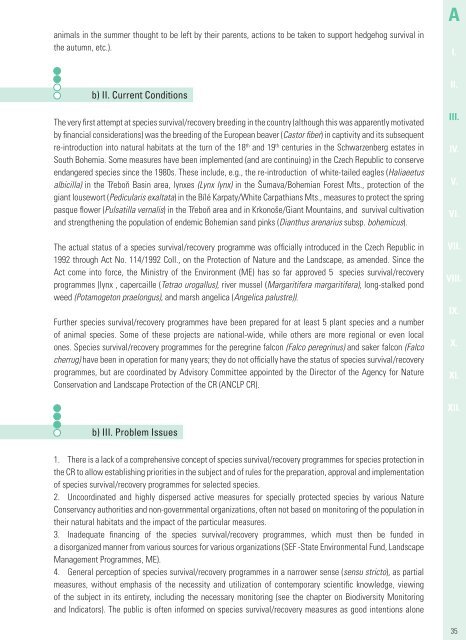B - Convention on Biological Diversity
B - Convention on Biological Diversity
B - Convention on Biological Diversity
- No tags were found...
Create successful ePaper yourself
Turn your PDF publications into a flip-book with our unique Google optimized e-Paper software.
animals in the summer thought to be left by their parents, acti<strong>on</strong>s to be taken to support hedgehog survival inthe autumn, etc.).AI.b) II. Current C<strong>on</strong>diti<strong>on</strong>sThe very first attempt at species survival/recovery breeding in the country (although this was apparently motivatedby financial c<strong>on</strong>siderati<strong>on</strong>s) was the breeding of the European beaver (Castor fi ber) in captivity and its subsequentre-introducti<strong>on</strong> into natural habitats at the turn of the 18 th and 19 th centuries in the Schwarzenberg estates inSouth Bohemia. Some measures have been implemented (and are c<strong>on</strong>tinuing) in the Czech Republic to c<strong>on</strong>serveendangered species since the 1980s. These include, e.g., the re-introducti<strong>on</strong> of white-tailed eagles (Haliaeetusalbicilla) in the Třeboň Basin area, lynxes (Lynx lynx) in the Šumava/Bohemian Forest Mts., protecti<strong>on</strong> of thegiant lousewort (Pedicularis exaltata) in the Bílé Karpaty/White Carpathians Mts., measures to protect the springpasque flower (Pulsatilla vernalis) in the Třeboň area and in Krk<strong>on</strong>oše/Giant Mountains, and survival cultivati<strong>on</strong>and strengthening the populati<strong>on</strong> of endemic Bohemian sand pinks (Dianthus arenarius subsp. bohemicus).The actual status of a species survival/recovery programme was officially introduced in the Czech Republic in1992 through Act No. 114/1992 Coll., <strong>on</strong> the Protecti<strong>on</strong> of Nature and the Landscape, as amended. Since theAct come into force, the Ministry of the Envir<strong>on</strong>ment (ME) has so far approved 5 species survival/recoveryprogrammes (lynx , capercaille (Tetrao urogallus), river mussel (Margaritifera margaritifera), l<strong>on</strong>g-stalked p<strong>on</strong>dweed (Potamoget<strong>on</strong> prael<strong>on</strong>gus), and marsh angelica (Angelica palustre)).Further species survival/recovery programmes have been prepared for at least 5 plant species and a numberof animal species. Some of these projects are nati<strong>on</strong>al-wide, while others are more regi<strong>on</strong>al or even local<strong>on</strong>es. Species survival/recovery programmes for the peregrine falc<strong>on</strong> (Falco peregrinus) and saker falc<strong>on</strong> (Falcocherrug) have been in operati<strong>on</strong> for many years; they do not officially have the status of species survival/recoveryprogrammes, but are coordinated by Advisory Committee appointed by the Director of the Agency for NatureC<strong>on</strong>servati<strong>on</strong> and Landscape Protecti<strong>on</strong> of the CR (ANCLP CR).II.III.IV.V.VI.VII.VIII.IX.X.XI.XII.b) III. Problem Issues1. There is a lack of a comprehensive c<strong>on</strong>cept of species survival/recovery programmes for species protecti<strong>on</strong> inthe CR to allow establishing priorities in the subject and of rules for the preparati<strong>on</strong>, approval and implementati<strong>on</strong>of species survival/recovery programmes for selected species.2. Uncoordinated and highly dispersed active measures for specially protected species by various NatureC<strong>on</strong>servancy authorities and n<strong>on</strong>-governmental organizati<strong>on</strong>s, often not based <strong>on</strong> m<strong>on</strong>itoring of the populati<strong>on</strong> intheir natural habitats and the impact of the particular measures.3. Inadequate financing of the species survival/recovery programmes, which must then be funded ina disorganized manner from various sources for various organizati<strong>on</strong>s (SEF -State Envir<strong>on</strong>mental Fund, LandscapeManagement Programmes, ME).4. General percepti<strong>on</strong> of species survival/recovery programmes in a narrower sense (sensu stricto), as partialmeasures, without emphasis of the necessity and utilizati<strong>on</strong> of c<strong>on</strong>temporary scientifi c knowledge, viewingof the subject in its entirety, including the necessary m<strong>on</strong>itoring (see the chapter <strong>on</strong> Biodiversity M<strong>on</strong>itoringand Indicators). The public is often informed <strong>on</strong> species survival/recovery measures as good intenti<strong>on</strong>s al<strong>on</strong>e35
















